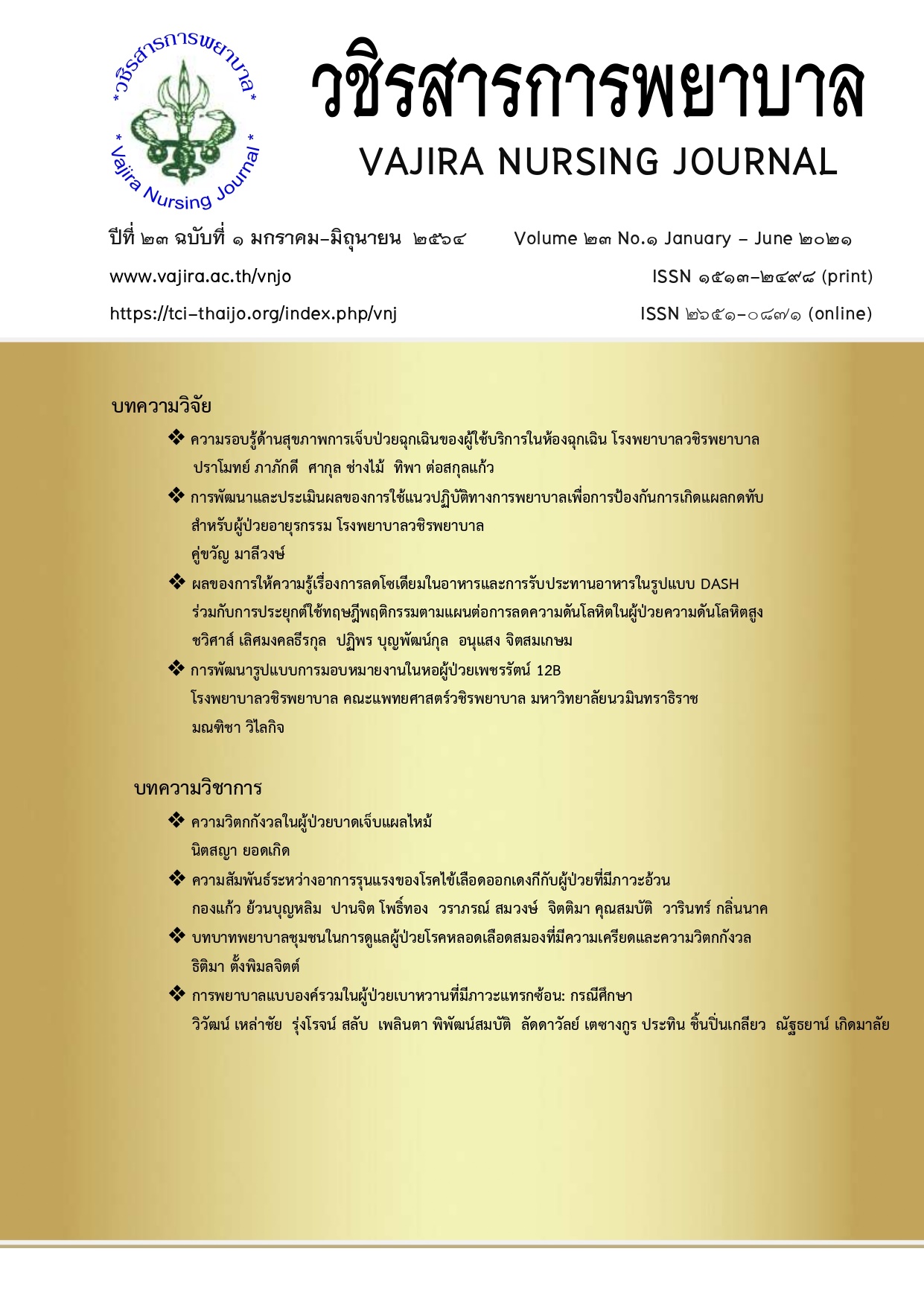บทบาทพยาบาลชุมชนในการดูแลผู้ป่วยโรคหลอดเลือดสมอง ที่มีความเครียดและความวิตกกังวล
Main Article Content
บทคัดย่อ
โรคหลอดเลือดสมอง เป็นปัญหาสาธารณสุขที่สำคัญระดับโลก เนื่องจากผู้ป่วยโรคหลอดเลือดสมอง ส่วนใหญ่เป็นผู้ป่วยที่มีความพิการ ความสามารถในการช่วยเหลือตนเองลดลง อีกทั้งผู้ป่วยโรคหลอดเลือดสมองยังมีความเสี่ยงในเกิดภาวะแทรกซ้อนเช่น ปอดอักเสบ แผลกดทับ การติดเชื้อทางเดินปัสสาวะ ส่งผลให้ผู้ป่วยเกิดความเครียด และวิตกกังวลขึ้น ดังนั้นพยาบาลชุมชนจึงเป็นบุคคลสำคัญในการดูแลผู้ป่วยต่อเนื่องที่บ้าน โดยมีการนำกระบวนการพยาบาลมาใช้ มุ่งเน้นการดูแลแบบองค์รวมทั้งกาย จิต สังคมและจิตวิญญาณ โดยมีการสร้างสัมพันธภาพกับผู้ป่วยเพื่อให้เกิดความไว้วางใจ การประเมินภาวะวิตกกังวลของผู้ป่วย การวิเคราะห์ปัญหาที่ทำให้ผู้ป่วยวิตกกังวล และวางแผนแก้ไขปัญหาความวิตกกังวลที่เกิดขึ้น ซึ่งจำเป็นต้องใช้กระบวนการพยาบาลมาปรับใช้ให้เหมาะสม ต้องใช้ทักษะในการสื่อสาร การรับฟังอย่างตั้งใจ การให้ความรู้เกี่ยวกับโรคและการปฏิบัติตัวที่ถูกต้อง การส่งเสริมพลังอำนาจในการดูแลตนเองของผู้ป่วย ให้กำลังใจในการเผชิญปัญหา ทั้งกับผู้ป่วยและผู้ดูแลผู้ป่วย โดยมีเป้าหมายการดูแลคือ เพื่อบรรเทาความวิตกกังวลและลดความเครียดให้กับผู้ป่วย
Article Details

อนุญาตภายใต้เงื่อนไข Creative Commons Attribution-NonCommercial-NoDerivatives 4.0 International License.
เนื้อหาและข้อมูลในบทความที่ลงตีพิมพ์ในวชิรสารการพยาบาลถือเป็นข้อคิดเห็นและความรับผิดชอบของผู้เขียนบทความโดยตรง ซึ่งกองบรรณาธิการไม่จำเป็นต้องเห็นด้วย หรือร่วมรับผิดชอบใด ๆ ทั้งสิ้น
บทความ ข้อมูล เนื้อหา รูปภาพ ฯลฯ ที่ได้รับการตีพิมพ์ในวชิรสารการพยาบาล ถือเป็นลิขสิทธิ์ของวชิรสารการพยาบาล หากบุคคลใดหรือหน่วยงานใดต้องการนำทั้งหมดหรือส่วนหนึ่งส่วนใดไปเผยแพร่ต่อหรือเพื่อกระทำการใด ๆ จะต้องได้รับอนุญาตเป็นลายลักอักษรจากวชิรสารการพยาบาลก่อนเท่านั้น
เอกสารอ้างอิง
กรมสุขภาพจิต กระทรวงสาธารณสุข. (2558). แนวทางการใช้เครื่องมือด้านสุขภาพจิต สำหรับบุคลากรสาธารณสุข ในโรงพยาบาลชุมชน (คลินิกโรคเรื้อรัง) ฉบับปรับปรุง. นนทบุรี: สำนักส่งเสริมและพัฒนาสุขภาพจิต กรมสุขภาพจิต.
กลุ่มยุทธศาสตร์ และแผนงานสำนักโรคไม่ติดต่อ. (2563). รายงานประจำปี 2562 กองโรคไม่ติดต่อกรมควบคุมโรค กระทรวงสาธารณสุข. สำนักพิมพ์อักษรกราฟฟิคแอนด์ดีไซน.
ขวัญพนมพร ธรรมไทย. (2554). การพยาบาลจิตเวชสู่การปฏิบัติ เล่ม 1. เชียงใหม่: โครงการตำราคณะพยาบาลศาสตร์มหาวิทยาลัย เชียงใหม่.
จิตรา รัตนดิลก ณ ภูเก็ต. (2549). การศึกษาความเครียดในการเผชิญความเครียดของญาติดูแลผู้ป่วยโรคหลอดเลือดสมอง. (สารนิพนธ์การศึกษามหาบัณฑิต). กรุงเทพฯ. มหาวิทยาลัยศรีนครินทรวิโรฒ.
พรพรรณ ศรีโสภา, ธนวรรณ อาษารัฐ. (2560). บทบาทพยาบาลในการป้องกันและจัดการความเครียด.บูรพาเวชสาร. (2), 79-92.
วราลักษณ์ ทองใบประสาท,ชมนาด วรรณพรศิริ,จรรยา สันตยากร, ทวีศักดิ์ ศิริพรไพบูลย์. (2550). ประสบการณ์การปรับตัวต่อการเจ็บป่วยของผู้ป่วยโรคหลอดเลือดสมองที่อาศัยในตำบลแสนตอ อำเภอขาณุวรลักษบุรี จังหวัดกำแพงเพชร. พิษณุโลก. มหาวิทยาลัยนเรศวร.
สมนึก สกุลหงส์โสภณ, สิริวรรณ อนันตโชค, กฤษณี โหลสกุล. (2554). ปัจจัยบางประการความสามารถในกิจวัตรประจำวันและภาวะแทรกซ้อนในผู้ป่วยอัมพาตจากหลอดเลือดสมองที่บ้าน. วารสารการพยาบาลและการศึกษา. 4 (2), 37-52.
สำนักพัฒนาสุขภาพจิต กรมสุขภาพจิต. (2556). คู่มือคลายเครียด (ฉบับปรับปรุงใหม่). กรุงเทพมหานคร: โรงพิมพ์ชุมนุมสหกรณ์การเกษตรแห่งประเทศไทย จำกัด.
สุรเกียรติ อาชานานุภาพ. (2553). ตำราการตรวจรักษาโรคทั่วไป 2: โรคกับการดูแลรักษาและการป้องกัน.(พิมพ์ครั้งที่5). กรุงเทพฯ. โฮลิสติก พับลิชชิ่ง.
อรุณี ชุนหบดี, ธิดารัตน์ สุภานันท์, โรชินี อุปรา, สุนทรีภรณ์ ทองไสย. (2556). ความเครียดและความต้องการของผู้ดูแลผู้ป่วยโรคหลอดเลือดสมองที่บ้าน. วารสารวิทยาลัยพยาบาลพระปกเกล้าจันทบุรี. 24 (1), 1-9.
Gallagher P. (2011). Becoming normal: a grounded theory study on the emotional process of stroke recovery. Canadian Journal of Neuroscience Nursing. 33 (3), 24-32.
Lazarus RS, Folkman S. (1984). Stress, appraise and coping. New York. Springer.
Selye H. (1976). Stress and inflammation. In Selye H editor. The stress of life. New York.McGraw-Hill.
Spielberger CD, Gorsuch RL. (1983). Manual for the state-trait anxiety inventory (STAI) for Y:self-evaluation questionnaire. Consulting Psychologists Press.
Struart GW, Sundeen SJ. (1995). Principle and practice of psychiatric nursing. 5th ed. ST Louis. Mosby.
World Stroke Organization:(WSO). (2017). World Stroke Day 2017. Retrieved 30 January 2021, From http://www.worldstrokecampaign.org/images2wsd-2017/brochures-2017/WSD_brochure_FINAL¬_sponser_.pdf.


